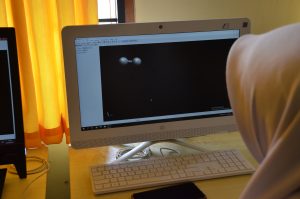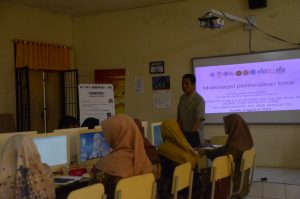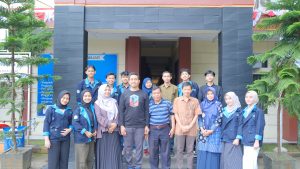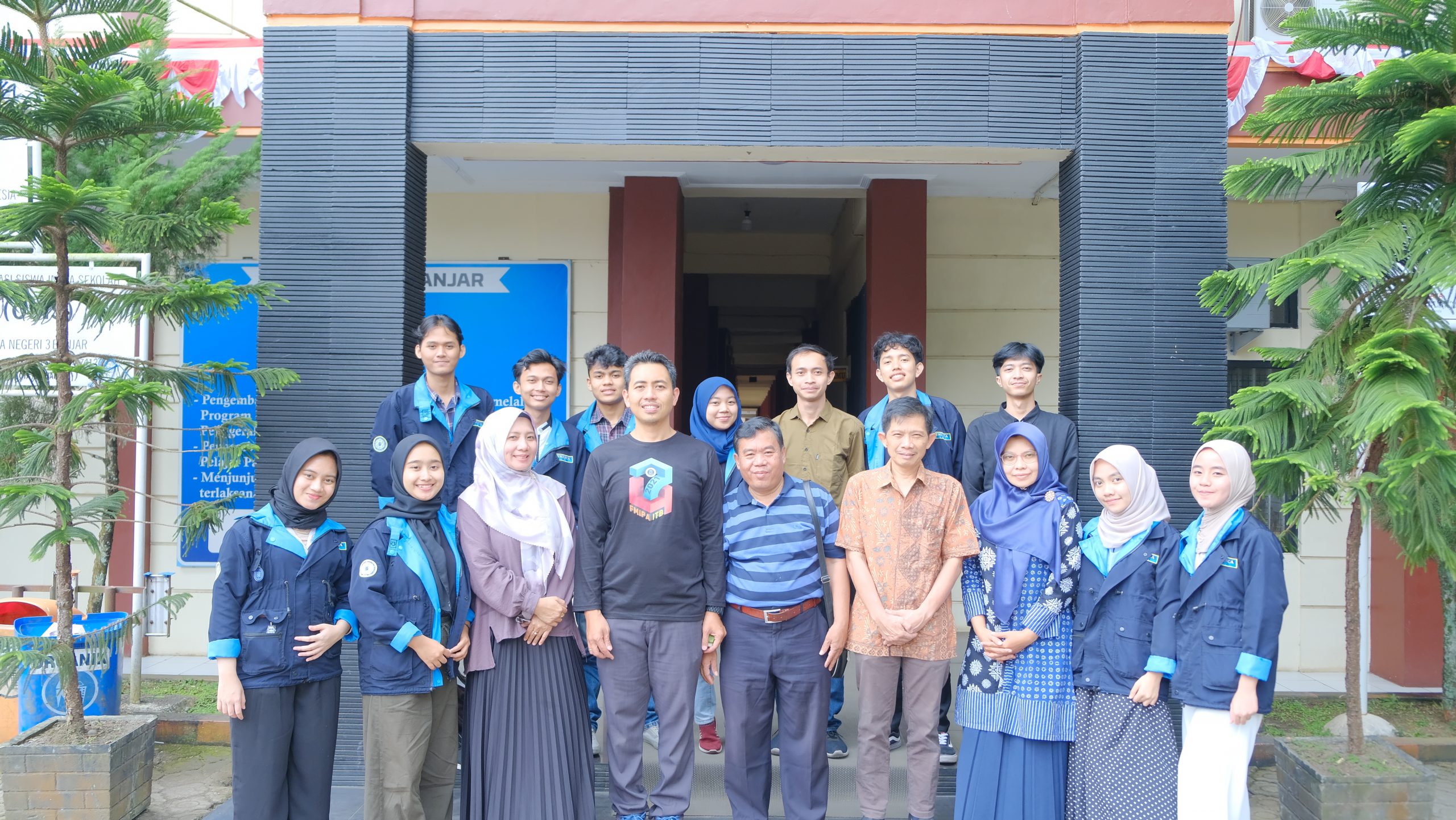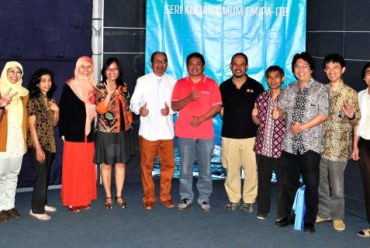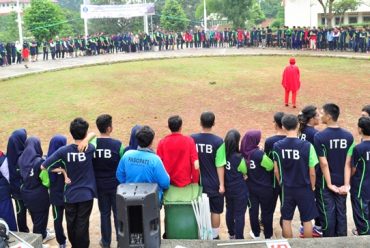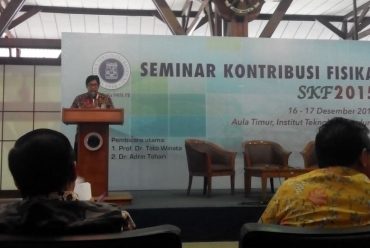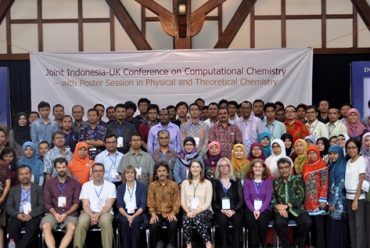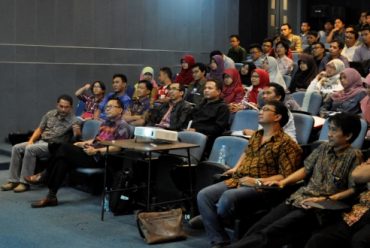Kolaborasi Kimia FMIPA ITB bersama komunitas kimiawan wilayah Jawa Barat dan mahasiswa kimia mengenalkan praktikum kimia aplikatif, safety laboratorium ke SMAN 3 Banjar
BA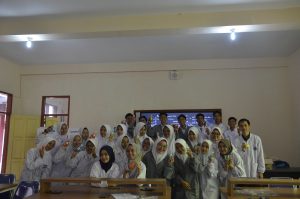 NDUNG, fmipa.itb.ac.id, -Dilatarbelakangi dengan kemungkinan atas kurangnya sinergi dari konsep keilmuan Ilmu Kimia yang diterima ketika SMA dengan yang kemudian dihadapi di tingkat Universitas, mengakibatkan mahasiswa memandang Ilmu Kimia sulit dihadapi dan tidak aplikatif. Sehingga dengan tujuan meningkatkan kualitas keilmuan antara pihak universitas dan pihak sekolah menengah atas, sejumlah akademisi, komunitas keprofesian, dan mahasiswa berkolaborasi berbagi keahlian untuk pengembangan pembelajaran Kimia. Kolaborasi ini tercipta dalam bentuk kegiatan pengabdian masyarakat di SMAN 3 Banjar, Kota Banjar, Jawa Barat. Pihak yang terlibat yaitu tim dari Program Studi Kimia FMIPA ITB bersama Jurusan Kimia FST UNJANI (Universitas Jenderal Achmad Yani), Program Studi Kimia FMIPA UMMI (Universitas Muhammadiyah Sukabumi), HKI Jabar-Banten (Himpunan Kimia Indonesia Cabang Jawa Barat-Banten), serta HMK (Himpunan Mahasiswa Kimia) “AMISCA” ITB.
NDUNG, fmipa.itb.ac.id, -Dilatarbelakangi dengan kemungkinan atas kurangnya sinergi dari konsep keilmuan Ilmu Kimia yang diterima ketika SMA dengan yang kemudian dihadapi di tingkat Universitas, mengakibatkan mahasiswa memandang Ilmu Kimia sulit dihadapi dan tidak aplikatif. Sehingga dengan tujuan meningkatkan kualitas keilmuan antara pihak universitas dan pihak sekolah menengah atas, sejumlah akademisi, komunitas keprofesian, dan mahasiswa berkolaborasi berbagi keahlian untuk pengembangan pembelajaran Kimia. Kolaborasi ini tercipta dalam bentuk kegiatan pengabdian masyarakat di SMAN 3 Banjar, Kota Banjar, Jawa Barat. Pihak yang terlibat yaitu tim dari Program Studi Kimia FMIPA ITB bersama Jurusan Kimia FST UNJANI (Universitas Jenderal Achmad Yani), Program Studi Kimia FMIPA UMMI (Universitas Muhammadiyah Sukabumi), HKI Jabar-Banten (Himpunan Kimia Indonesia Cabang Jawa Barat-Banten), serta HMK (Himpunan Mahasiswa Kimia) “AMISCA” ITB.
Kegiatan ini mengusung tema “Penerapan Modul Kimia Aplikatif dan Safetylab dalam Meningkatkan Kepedulian Lingkungan dan Pembelajaran untuk Siswa Menengah Atas Wilayah Selatan Jawa Barat.” Kegiatan yang diselenggarakan oleh dosen dan mahasiswa ini dilaksanakan selama dua hari, yaitu tanggal 5-6 Agustus 2023 secara offline dan online. Kegiatan ini merupakan keberlanjutan kolaborasi antar Jurusan Kimia dari berbagai universitas di wilayah Jawa Barat yang tergabung dalam HKI Jabar-Banten. Seperti halnya kegiatan di tahun-tahun sebelumnya, kolaborasi ini merambah ke daerah selatan wilayah Jawa Barat dengan variasi kontribusi yang berbeda-beda dalam bentuk praktikum, penyuluhan, dan FGD.
Dr. Muhammad Yudhistira Azis, Dosen Kimia, Kelompok Keilmuan Kimia Analitik Program Studi Kimia FMIPA ITB sekaligus sebagai Ketua Himpunan Kimia Indonesia cabang Jawa Barat-Banten dan ketua pelaksana menyatakan kegiatan ini merupakan kegiatan tahun ketiga bersama akademisi jurusan kimia wilayah Jawa Barat-Banten dengan lokasi yang lebih luas di wilayah selatan Jabar, seperti kabupaten Tasikmalaya, kabupaten Garut dan sekarang di kota Banjar. Keterlibatan akademisi yang berkolaborasi dapat memilih lokasi, dan materi yang diberikan lebih beragam, terkait peningkatan keterampilan dan peningkatan kualitas pembelajaran ilmu kimia untuk siswa SMA khususnya juga guru-guru kimia di wilayah tersebut”.
Kegiatan di SMAN 3 Banjar meliputi pelatihan pembuatan sabun, pembuatan penyaringan air sederhana, pengenalan terkait chempreneur, pemasaran produk berbasis digital, penyuluhan dampak serta identifikasi pencemaran, dan percobaan berbasis kimia komputasi. Selain itu, dilakukan juga FGD antar guru-guru Kimia Kota Banjar dalam membahas miskonsepsi konsep pembelajaran Kimia antara tingkat SMA dengan universitas.
Kepala Sekolah SMAN 3 Banjar, Dr. Endang Mulyadi menyambut baik kegiatan ini. Beliau menyatakan bahwa kemampuan dasar sains siswa sangat erat kaitannya dengan kehidupan sehari-hari. Dengan pemahaman akan hal tersebut, siswa akan dapat memberikan kontribusi nyata dan berkreasi sambil belajar. Siswa pun akan memperoleh insight bahwa Ilmu Kimia bukan sesuatu yang perlu ditakuti, sehingga branding Ilmu Kimia dapat makin melekat dan nantinya akam semakin dipertimbangkan sebagai pilihan dalam melanjutkan studi ke universitas.
Dalam upaya meningkatkan pemahaman dan pengetahuan guru maupun siswa SMA terkait materi pembelajaran Kimia, diperlukan inovasi untuk menunjang pemahaman siswa, dapat melalui praktikum kombinasi dan aplikatif. Diharapkan hal tersebut dapat memudahkan siswa dalam memahami teori yang diajarkan di sekolah, sekaligus mewadahi siswa meningkatkan keterampilan di laboratorium dan memahami penggunaan bahan kimia serta dampaknya jika disalahgunakan ke lingkungan.
Melalui percobaan aplikatif analisis kualitas air di lingkungan, siswa dapat berkontribusi aktif dalam memberikan informasi kualitas air bersih di desa maupun di sekolah. Selain itu, melalui percobaan pembuatan produk dapat meningkatkan minat siswa untuk menghasilkan karya yang inovatif dan menumbuhkan karakter sainspreneur. Hal menarik lainnya sekaligus merupakan materi yang baru adalah pengenalan komputasi untuk siswa dan guru SMA, melalui materi yang diimplementasikan secara visual. Diharapkan akan dapat meningkatkan pemahaman siswa dalam melihat struktur molekul kimia yang sebelumnya hanya dikenal melalui teori dan tidak bisa dilihat secara kasat mata.
Pengetahuan siswa dan guru di tingkat menengah atas dalam hal safety laboratorium juga sangat penting agar dapat melindungi siswa dan guru dari kontaminasi bahan kimia. Hal ini sangat baik jika diajarkan sejak tingkat SMA agar di level perguruan tinggi maupun industri, mereka telah terbiasa dan mampu menghindari bahaya dan kecelakaan di laboratorium.
Kegiatan ini diikuti oleh 50 siswa dan 20 guru IPA SMAN 3 Banjar. Respon dari guru Kimia Kota Banjar yang berpartisipasi dalam kegiatan ini sangat positif. Guru-guru tersebut menyambut baik kegiatan kolaborasi antar universitas dan komunitas ini dan diharapkan dapat menjadi kegiatan rutin di SMAN 3 Banjar. Interaksi elemen-elemen di universitas dengan sekolah tingkat menengah merupakan langkah awal dalam mempererat koordinasi dan komunikasi keilmuan dan keprofesian pendidikan kimia agar siap memenuhi kebutuhan sumber daya manusia di dunia industri dan profesional lainnya.
Harapan kedepannya, dinas terkait juga dapat berkolaborasi dalam kegiatan sejenis ini. Dengan adanya interaksi antara dosen, guru, mahasiswa, dan siswa ini akan sangat membantu dalam bersinergi dan berbagi keilmuan. Selain memberikan branding Kimia secara keilmuan, universitas pendukung kegiatan ini dapat turut mempromosikan program studinya ke siswa SMA terkait. Semoga Ilmu Kimia dapat semakin dicintai dan memberikan banyak manfaat bagi generasi muda kedepan. (MYA)
